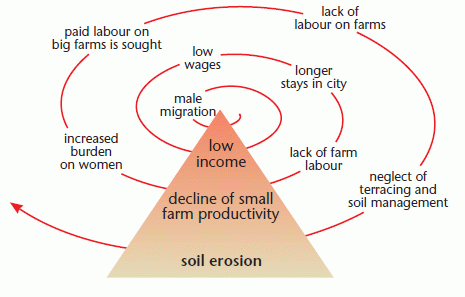Saving the world’s soils
Nature of the problem
In many places around the world the natural equilibrium of the soil is being disturbed by human activities. Many people view the land as a resource that belongs to them, to be used in whichever way they think fit. This is an abusive way of using the soil that will eventually destroy the land we seek to use. Across the world, farmers are attempting to feed 90 million extra mouths per year. This is against a backdrop of massive soil erosion, of some 24 billion tonnes/year. Cropable land is actually shrinking!
Soil erosion is just one form of soil degradation. Others are soil compaction, low organic matter, loss of structure, salinisation and acidity problems.
Amplification
Under normal conditions soil erosion is a natural process occurring under nonagricultural conditions; i.e. the removal of material by erosion at the surface and the addition of material by weathering is part of the fine balance typical of natural soils. Soil erosion only becomes a problem when the rate of removal of soil by water and/or wind exceeds the rate of soil formation. Accelerated soil erosion normally results from the removal of the surface protection afforded by natural vegetation, but can be the result of changes in soil conditions brought about by climatic change. An explanation of the causal factors of soil erosion is shown in the diagram below.
Sheet, rill and gully erosion are the main forms of water erosion. Wind erosion is able to strip as much soil as these three processes put together.

CASE STUDY - War, poverty and disease? Africa’s soil may be its worst enemy - ‘Deforestation, overgrazing and harmful irrigation practices are transforming vast areas of the world’s poorest continent into virtual wasteland. National economies are crippled, fueling social and political havoc.’
Farmers are feeling the effects of generations of exploitation. Africa was once a place of plenty, hillsides now lie bare from years of erosion. Unless current trends are reversed, Africa will be unable to feed two-thirds of a projected 1 billion population in 2025. Already 200 million people are chronically malnourished, double the figure 30 years ago. Most Africans today eat about four-fifths of what they did in the 1950s, when the continent was a net exporter of food. And it all comes down to the soil.
In an era when chemical fertilizers, pesticides and modern machinery have boosted food production to record levels in the United States and Canada, African farmers struggle to survive using shortsighted farming methods that often degrade the fragile soil. For generations, subsistence planters, stock herders and loggers have engaged in a battle with the land. They slash and burn virgin forests and savanna grasslands, often replacing them with cash crops that leech life-giving nutrients such as potassium and nitrogen from the soil. Rapid population growth in burgeoning urban slums has increased the pressure on the overtaxed soil. UN studies suggest ‘the low fertility of African soils is the single most critical impediment to the region’s economic development’. ‘Real progress will not be made in Africa until the problem of degraded soil is addressed.’ Already 2.2 million km2 is classified as degraded land.
As long as civil wars and political upheaval are rife, with foreign aid money going first toward peace-keeping missions and refugee disasters, the agricultural problem on the land and development will be neglected.
Source: Associated Press 16.10.99
CASE STUDY - The problem of wind erosion in North America - Wind erosion is a serious problem in many parts of the world. In the USA, 70 years after the notorious black blizzards of the Dust Bowl, the Great Plains are still losing 30 million ha of land to damage from the wind per year. Blowing soil reduces seedling survival and growth, depresses crop yields, lowers the marketability of vegetable crops, makes crops susceptible to disease and contributes to pathogen transmission. Put together this amounts, in Kansas, to a 340 000 bushel yield reduction of wheat and a 540 000 bushel yield reduction of sorghum.
Most of the eroded soil enters the atmospheric dust load, where it pollutes the air, fills ditches, fouls machinery and imperils human and animal health, e.g. on a 500 m stretch of Kansas highway 965 tonnes of soil was removed in 1996! Wind erosion in the USA is a threat to the sustainability of the land as well as the quality and viability of life for rural and urban communities.
Source: US Wind Erosion Research Unit
Summary
Management of soil degradation at a global, regional and local scale is a complex issue; one which represents one of our most challenging environmental problems. The challenge according to the World Soil Charter (part of FAO) ‘is for governments and landowners to manage the land for long term advantage rather than for short term expediency’.

